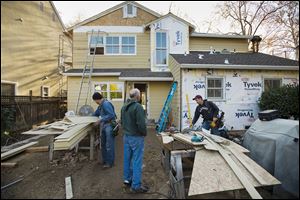
Remodeling industry picking up pace
Homeowners use low rates and rising equity to add on, not move out
12/15/2013
A crew from Abrahams Construction adds a second story with two bedrooms and two baths in Sacramento. Builders say more homeowners are investing in remodeling projects they’ve put off.
SACRAMENTO — With a baby on the way earlier this year, Jeff and Meredith Schaff decided they needed more room than their small three-bedroom, one-bath starter home could provide.
“We definitely knew we needed a second bathroom,” Mr. Schaff said.
But when they started looking at homes to buy at a time of tight inventory and sharply rising prices, they said it was tough finding anything in their price range that would fit their needs. Instead they decided to stay in Sacramento’s Land Park neighborhood and add a second bath and walk-in closet and remodel the kitchen in their craftsman cottage.
They spent about $100,000, but they figured they saved $75,000 over the cost of a similarly appointed resale home and got just what they wanted.
The Schaffs are among homeowners who, faced with the prospect of moving or taking on major renovations, are opting to remodel.
Growing confidence in the economy, rising home equity, and low interest rates are among the factors giving renewed energy to the remodeling industry, which went slack during the downturn, builders said.
“We’re really happy to see these large investments come back,”said Mark Abrahams of Abrahams Construction, a residential remodeling specialist in Land Park who renovated the Schaffs’ home.
The National Association of the Remodeling Industry, a trade association representing 7,000 construction firms, said its most recent quarterly survey of builders showed growing business from homeowners based on improving home prices, economic growth, and more certainty about the future. But the main driver of growth is homeowners who are undertaking renovations they put off in the recession, the survey suggested.
“We believe what’s going on now are postponed projects,” said Tom O’Grady, a suburban Philadelphia builder who is on the association’s board of directors and chairman of its strategic planning and research committee. “People are more optimistic about their portfolios. That’s what’s driving all of this.”
Mr. Abrahams said rising home values give homeowners the sense that their investments will pay off. When values were sinking, they feared they would lose money from major home improvements. That feeling is reversing, he said.
Another client, Rochelle Kaye, said the sense that values were ticking up helped her husband decide that now was the time to add a long-desired covered backyard patio with a fireplace to their Land Park house.
“...We might as well do it now and enjoy it when the kids are here,” she said. “We know we’re not going to lose money.”
Others cited the relative affordability of remodels, with builders willing to negotiate on price and interest rates near record lows. Refinancings with cash-outs and home equity and renovation loans are among the options.
Susan Zdarko said she refinanced to add a second story to her cottage.
“Interest rates are historically the lowest they’ve been in my lifetime,” she said. “It was the perfect opportunity — and being able to get quality builders who were still on the slow side but recognizing that wouldn’t last for much longer.”
John Caulfield, owner of Landmark Builders in Granite Bay, Calif., said the lack of desirable resale inventory is a factor driving many homeowners to do major upgrades.
In Granite Bay, million-dollar homes on the market often still need a lot of work to bring them up to the standards of well-heeled buyers, he said. These sellers had put off upgrades too.
Now a number of homeowners have done remodels costing $200,000 to $400,000, including gutting an entire interior or adding 2,000 square feet.
By remodeling, they avoid hefty real estate commissions and moving costs.